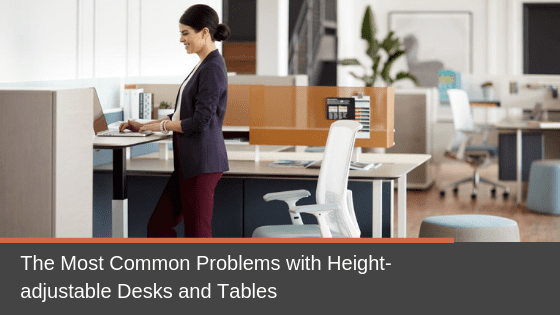For the past decade, there has been a growing trend toward ergonomic office furniture design. One piece of furniture that has grown in popularity is the height-adjustable desk. Recently, there have been many new designs that have added features making your choices better than ever.
As the data on height-adjustable desks have come in, some problems are coming to light regarding their use. In this article, we’re going to take a look at some of these problems and offer solutions to make the transition easier.
The Problems with Height-adjustable Desks
While height-adjustable desks can increase productivity and offer other benefits if properly used, there can be some challenges when making the transition. Here are some common problems you may encounter when making the switch, and some simple solutions that can make transitioning easier.
Problem #1 – Standing for Too Long
Sometimes users stand for longer than they should, thinking that the longer they stand, the more they will benefit. But, attempting to stand for the full workday is just as harmful as sitting all day.
A 2018 study by the Journal of Epidemiology indicated that “occupations involving predominantly standing were associated with an approximately 2-fold risk of heart disease compared with occupations involving predominantly sitting.”
Standing for too long while working can put more strain on the back, legs and feet, increase the risk of varicose veins, is more straining on the circulatory system, and for pregnant workers, can cause complications.
The Solution
To reap the full benefits of a height-adjustable desk it’s essential to change your position a few times every hour – not stand or sit for long periods. Ongoing education and training are vital in ensuring employees are using their desks properly and let them know their employers have a vested interest in their health and wellness.
Problem #2 – It Feels Weird
When you first try a height-adjustable desk, it can feel…well…weird. Initially, it’s a strange feeling to stand and type at a computer. You might find that you want to give up right away and sit back down.
During the first few days of use, you might find that you have some muscle soreness and fatigue at the end of the day. The initial transition to standing and sitting at the computer can take some getting used to.
The Solution
Taking frequent breaks when first making the transition can be extremely helpful. Try taking a walk during your break, or incorporating movement into your work routine. Marching in place at your workstation can increase blood flow and prevent fatigue.
Consider adding an anti-fatigue mat to help reduce stress on joints and bones. Good supportive shoes can also make a big difference.
Problem #3 – Giving Up on Your Height-adjustable Desk
It takes a commitment and stamina to get through the initially uncomfortable aspects of switching to be successful. As a result, many users give up. Studies performed at Cornell University showed that the use of sit-stand workstations declines after about a month. Many people give up and return to sitting.
This problem is particularly prominent when an organization decides to roll out height-adjustable desks to all its employees. Without the right training, your team may not bother to adopt their new height-adjustable desk.
The Solution
We’re all creatures of habit and making it a habit to use your height-adjustable desk is the best way to incorporate it into your everyday work routine. It takes about three weeks to develop a new habit.
Try creating a routine when first adjusting like sitting and working for 20 minutes, following that with 8 to 10 minutes of standing, then taking a few minutes just to walk. Repeat this routine throughout the day and gradually increase the time spent standing. In a month, you’ll wonder why you haven’t tried this sooner!
Problem #4 – Manually Changing the Height is Distracting
Some height-adjustable desks require the user to manually adjust the height of their desk using a hand crank, which means they need to stop what they’re doing and spend the 20 – 30 seconds required to adjust it.
Not only does this disrupt the user’s focus every time they need to change their position, but it also means they’re less likely to make that shift in posture.
The Solution
Consider an electric or pneumatic adjustable sit-stand desk. These desks allow the work area height to be adjusted to fit the user quickly and efficiently; and by making the process easier, employees are more likely change between sitting and standing position more frequently throughout the day.
Given These Challenges, Is an Adjustable Desk Worth Your Investment?
Well, our answer is….it depends. On the one hand, height-adjustable desks won’t be useful if they go under-used, over-used or are not used correctly.
However, with training, encouragement and support to ensure users are comfortable using them, height-adjustable desks can make a significant difference in the health, wellness and productivity of you or your team.
In all our years selling height-adjustable desk at Office Interiors, our only customers unsatisfied with their purchase are those who did not adjust their habits to use the desk as frequently as recommended.
Learn more about office ergonomics and how it can improve the health, happiness of your team in our guide “Office Ergonomics: What it is, Why it Matters, & What You Can Do About It today!”.
Cory Porteous
Director of Marketing & Inbound Business Development
Office Interiors




